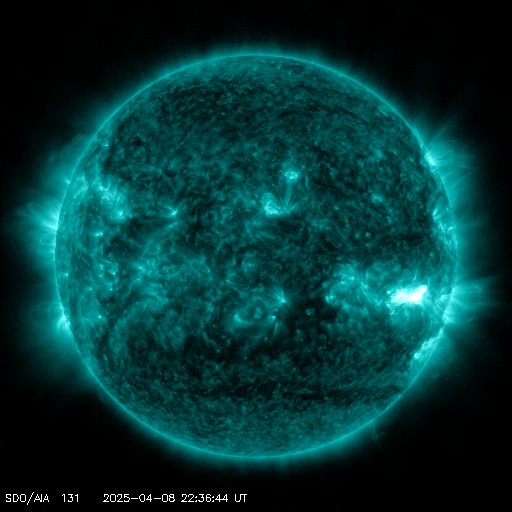Viewing archive of Monday, 26 September 2011
Solar activity report
Any mentioned solar flare in this report has a scaling factor applied by the Space Weather Prediction Center (SWPC). Because of the SWPC scaling factor, solar flares are reported as 42% smaller than for the science quality data. The scaling factor has been removed from our archived solar flare data to reflect the true physical units.
Report of Solar-Geophysical Activity 2011 Sep 26 2200 UTCPrepared by the NOAA © SWPC and processed by SpaceWeatherLive.com
Joint USAF/NOAA Report of Solar and Geophysical Activity
SDF Number 269 Issued at 2200Z on 26 Sep 2011IA. Analysis of Solar Active Regions and Activity from 25-2100Z to 26-2100Z
Solar activity has been at moderate levels for the past
24 hours. Region 1302 (N13E23) produced the largest event of the
period, a M2 x-ray flare at 1446Z. Region 1301 (N17W23) and Region
1303 (S28W90) also produced several low level C-class events.
IB. Solar Activity Forecast
Solar activity is expected to remain
at moderate levels on day one (27 September). Low to moderate levels
are expected on day two (28 September) and predominantly low levels
are expected on day three (29 September). Region 1302 remains the
most active Region on the disk but has only produced one M-class
event over the past 24 hours.
IIA. Geophysical Activity Summary 25-2100Z to 26-2100Z
The geomagnetic field has been at major storm levels for the past 24
hours. A CME, observed leaving the solar disk on 24 September,
arrived at Earth on 26/1237Z. Indicating the arrival of the CME, a
45 nT sudden impulse was observed by the Boulder magnetometer. As
the CME progressed, measurements by the ACE spacecraft showed the
total IMF reaching a peak of 33 nT, with the negative (Southward
Component, Bz) reaching a maximum of-31 nT. Solar wind speeds
increased from around 350 km/s to 650 km/s. During the CME passage,
both GOES 13 and GOES 15 spacecraft showed clear magnetopause
crossings. The greater than 10 MeV proton event, that began at
23/2255Z, reached up to 35.7 pfu at 26/1115Z, and continues to
remain above the 10 pfu threshold.
IIB. Geophysical Activity Forecast
The geomagnetic field is
expected to be at unsettled to active levels for the next two days
(27-28 September) with a slight chance for minor storm levels, due
to the trailing effects of the latest CME and the possible arrival
of a second CME. A return to predominately quiet levels is expected
on day three (29 September).
III. Event Probabilities 27 Sep to 29 Sep
| Class M | 80% | 40% | 30% |
| Class X | 40% | 10% | 05% |
| Proton | 99% | 30% | 10% |
| PCAF | yellow | ||
IV. Penticton 10.7 cm Flux
Observed 26 Sep 148 Predicted 27 Sep-29 Sep 145/145/140 90 Day Mean 26 Sep 108
V. Geomagnetic A Indices
Observed Afr/Ap 25 Sep 004/004 Estimated Afr/Ap 26 Sep 027/060 Predicted Afr/Ap 27 Sep-29 Sep 012/010-010/015-005/005
VI. Geomagnetic Activity Probabilities 27 Sep to 29 Sep
| A. Middle Latitudes | |||
|---|---|---|---|
| Active | 30% | 15% | 05% |
| Minor storm | 15% | 05% | 01% |
| Major-severe storm | 05% | 01% | 01% |
| B. High Latitudes | |||
|---|---|---|---|
| Active | 35% | 20% | 10% |
| Minor storm | 10% | 10% | 01% |
| Major-severe storm | 05% | 01% | 01% |
All times in UTC
Current data suggests there is a slight possibility for aurora to appear at the following high latitude regions in the near future
Gillam, MB, Iqaluit, NUNuuk
Latest news
Latest forum messages
AR4048 128Incoming & Unnumbered Active Regions 1678Sunspot Latitudes at or near Solar Maximum 85New satellites - Proba-3, PUNCH, SWFO-L1, GOES-U/19 47AR 4054 21
More topicsSupport SpaceWeatherLive.com!
A lot of people come to SpaceWeatherLive to follow the Sun's activity or if there is aurora to be seen, but with more traffic comes higher server costs. Consider a donation if you enjoy SpaceWeatherLive so we can keep the website online!

Latest alerts
02:00 UTC - Geomagnetic activity
Minor G1 geomagnetic storm (Kp5) Threshold Reached: 01:45 UTC
Tuesday, 8 April 2025
23:57 UTC - Hemispheric Power Index
The OVATION model predicts the Hemispheric Power Index to reach 50GW at 00:44 UTC
22:42 UTC - Solar flare
Moderate M1.57 flare
22:24 UTC - Radio Blackout
Minor R1 radio blackout in progress (≥M1 - current: M1.52)
15:15 UTC - Geomagnetic activity
Minor G1 geomagnetic storm (Kp5) Threshold Reached: 14:59 UTC
Space weather facts
| Last X-flare | 2025/03/28 | X1.1 |
| Last M-flare | 2025/04/08 | M1.5 |
| Last geomagnetic storm | 2025/04/06 | Kp5 (G1) |
| Spotless days | |
|---|---|
| Last spotless day | 2022/06/08 |
| Monthly mean Sunspot Number | |
|---|---|
| March 2025 | 134.2 -20.4 |
| April 2025 | 151.3 +17.1 |
| Last 30 days | 137.4 +0.1 |





